James Miller travels the east coast of Sicily to discover two cities rich in ancient history and vibrant with modern life…
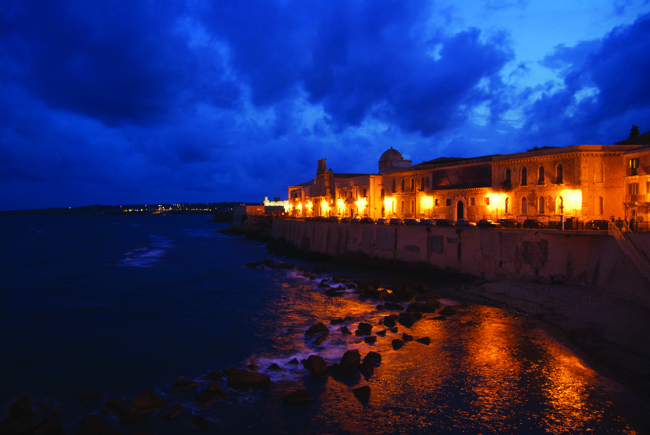
The Roman statesman and scholar Cicero described Siracusa as “The greatest Greek city and the most beautiful of them all.” In ancient times Sicily was once part of Magna Graecia, or Greater Greece, and Siracusa was an influential and important city in Europe’s Hellenistic period. I have seen much of Sicily on my Italian travels, but Siracusa had been on my list of must-see destinations for years. I was on a trip to explore two towns on the eastern side of the island, Siracusa first, then Taormina. As I followed the beautiful coastal route along the northeast of the island I was eagerly anticipating the experiences that awaited me.
It was late afternoon and after a long journey from the capital, Palermo, I finally arrived at Ortigia, Siracusa’s historic centre, which, curiously, is an island in its own right. After checking into my home for the night, the perfectly located Hotel Des Etrangers, I headed straight to the centre of the city, the Piazza Duomo, famous for being the most beautiful baroque piazza in Sicily. It has been used as a film location for Italian masterpieces such as Malèna, Giuseppe Tornatore’s war-time classic starring Monica Belluci as a tragic war widow, isolated and mistreated by the local women.
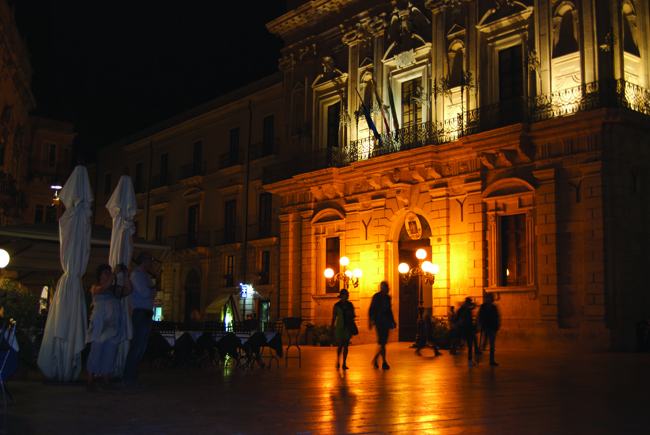
As I walked up to the piazza I could certainly see why this was selected as a film set. This enchanting open space, encircled by buildings with stunning Classical architecture, was certainly cinematic and evoked a sense of drama. However, I felt anything but isolated and tragic in this incredible space – the piazza was buzzing with tourists and children playing, creating an ambience and an urge to stay. I acted upon this impulse by sitting in one of the cafés lining the piazza and enjoying a couple of glasses of delicious local white wine. The experience was one of contentment and serenity, complemented by the melodic and moody strumming of a talented guitarist. This maestro in the middle of the piazza created an ambience that just completed the moment. Later the guitar music was replaced by an opera singer, bellowing out famous Italian arias.
The piazza’s showpiece is the magnificent baroque cathedral. The cathedral has evolved through a number of incarnations. Originally a 5th-century temple dedicated to the goddess Minerva, it was later developed by the Byzantines and then the Normans. I sat and gazed in awe at the detail of the huge Corinthian columns that flanked the cathedral’s façade.
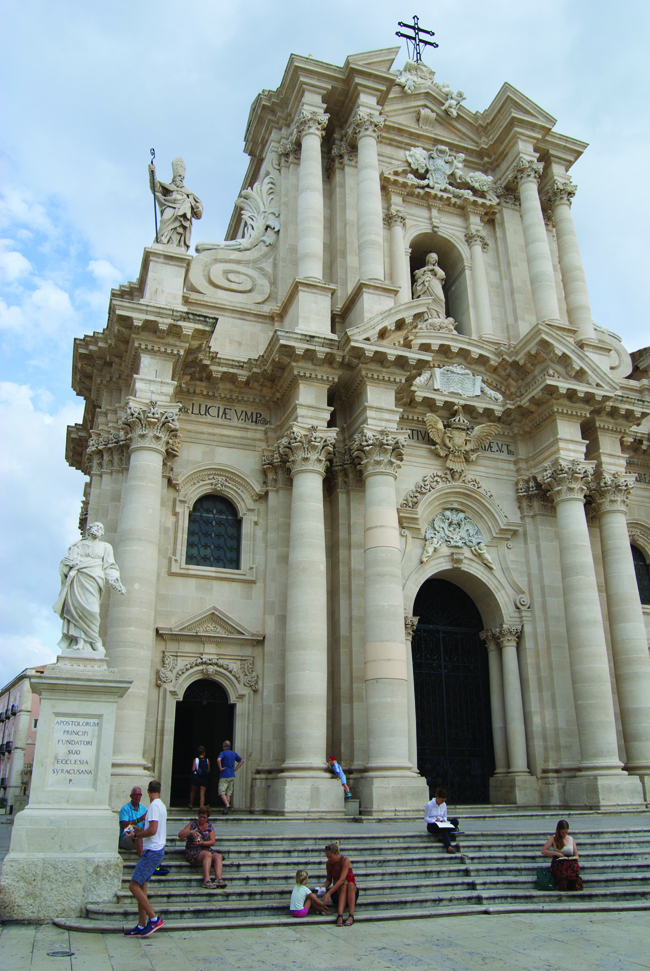
After lunch I decided to explore the area further and wandered through the narrow Ortigian streets, each one more attractive than the last. These back streets are quite unique with their characteristic Sicilian baroque architecture and captivating balconies that are clearly a source of local pride.
Later that evening I ventured into some of the bars to sample the local nightlife. I found myself chatting to a fellow countryman who had visited Sicily and decided to make his home here. I asked him what Sicily offered him that Britain didn’t. His answer was simple and profound: “Sicily offers me time – and space.”
I was then drawn to the gloriously raucous music from a nearby club which is where I met the charismatic and talented singer Ramona, something of a celebrity in the local music scene. Typical of Sicilians, Ramona was generous of spirit and delighted to meet someone interested in her culture, offering to be my tour guide the next day.
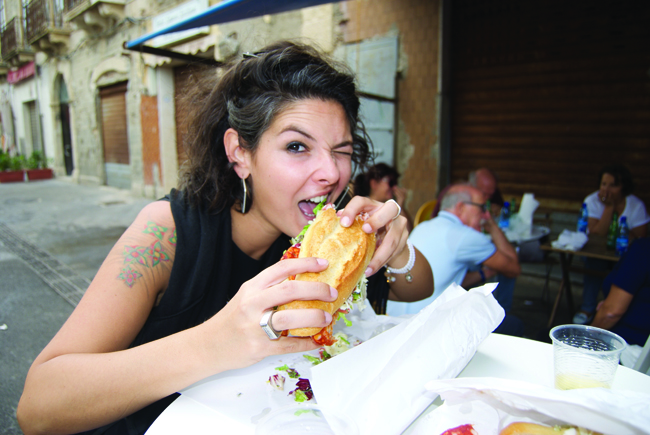
That night I walked back through the piazza. Despite the rain, it had lost none of its beauty. The splashes on the paving illuminated by the soft street lights and warm orange glow of the baroque buildings created a spellbinding interplay of water and light.
My stay at the Hotel Des Etrangers was perfect, the décor was elegant and the room spacious and comfortable. I awoke to the drama of lightning flashes from an uncharacteristic storm across the harbour, but the comfort of the hotel ensured I was asleep again in no time and ready to face the next day with my tour guide, Ramona.
The weather had cleared up. It was bright and sunny when I met Ramona at the appointed place, the Cannoli del Re kiosk. What a way to start the day, Sicilian style: cannoli and coffee. Ramona greeted me like an old friend and off we went. We walked across the Piazza Duomo and spotted a newly-wed couple parading their marital happiness to the tourists. The bride looked stunning and the groom was beaming, the term fare la bella figura had never been more apt.
Ramona is larger than life and she cherishes her beloved Sicilian culture. We walked past the ruins of the 6th-century BC Temple of Apollo, a spectacular sight that Ramona pointed out was the first Doric temple in Sicily. Our next stop was the market place, the Mercato di Ortigia. Ramona was greeted by the market traders, particularly the traders in the Pescheria Fratelli Cappuccio. One of the Cappuccio family, a rotund, moustachioed, jolly man broke into song when he saw and gave her a big hug. Born and bred in Ortigia, Ramona is a daughter of the city, warmly greeted where ever she goes. I had been very fortunate in finding a tour guide who was so much part of the fabric of the local culture.
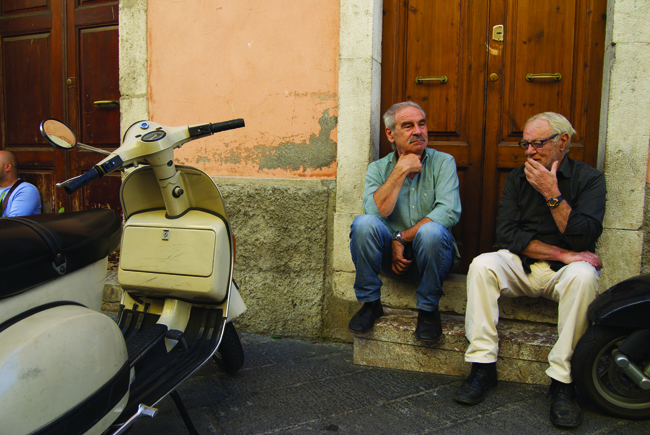
Next Ramona took me to the wine bar Solaria where, unsurprisingly, she was friends with the staff. We sat and talked about life, love and loss. Ramona has a vibrant career singing in the clubs and bars of Siracusa. She explained that despite the travelling her career offers, when she is out of Ortigia she feels like a fish out of water.
Ramona then took me to the one of Ortigia’s most famous destinations, the extraordinary Fountain of Arethusa, a freshwater spring that flows to the sea. The fountain has papyrus growing in it and is the home to a number of carp, one of which Ramona took a great interest in due to its recent growth spurt – this carp was obviously part of the local community!
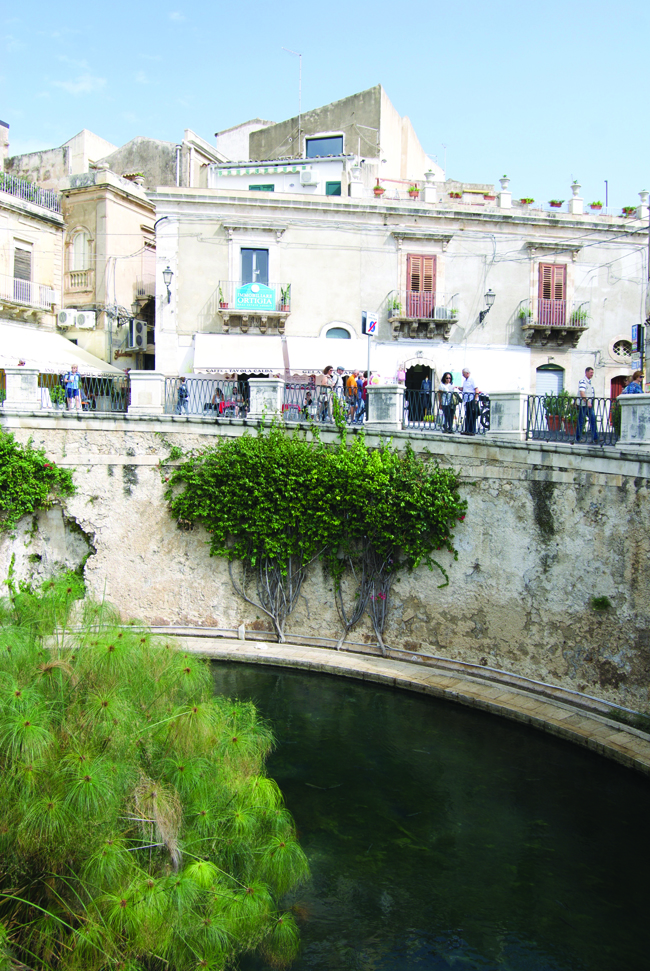
She enthusiastically explained the Greek legend attributed to the fountain’s origins. Arethusa was a nymph who was transformed into a spring to escape the amorous advances of Alpheus, son of the god Oceanus. After my lesson in Greek mythology we opted for a caffeine break. Ramona insisted I be an Ortigian for the day and therefore the English custom of tea was banned in favour of espresso!
Sat relaxed, movie-star shades on looking out to the sea, Ramona seemed to be completely in her element. “There are many places in Siracusa and Ortigia to think about life and reflect,” she explained as she stared out to the harbour. It was clear to me that Ramona belonged to a tight-knit community with old world values and an appreciation for the simple pleasures life offers, in a sense shielded from the complications and pace of city life.
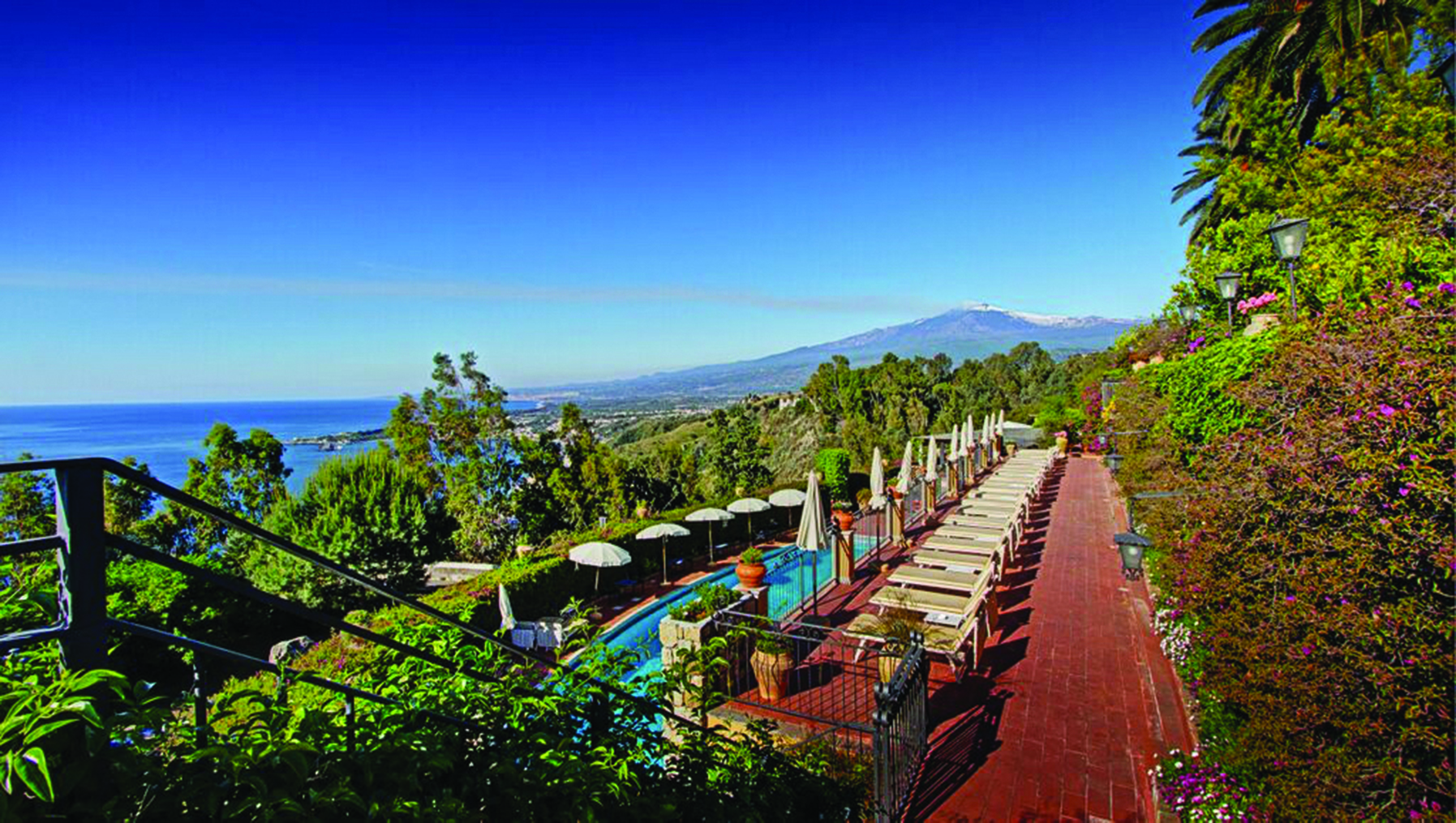
The next destination was the old fish market that had been transformed into an antiques emporium for the day. We looked at some beautiful old furniture and relics of Ortigia’s past, such as a local car registration plate from an era when cars were a novelty.
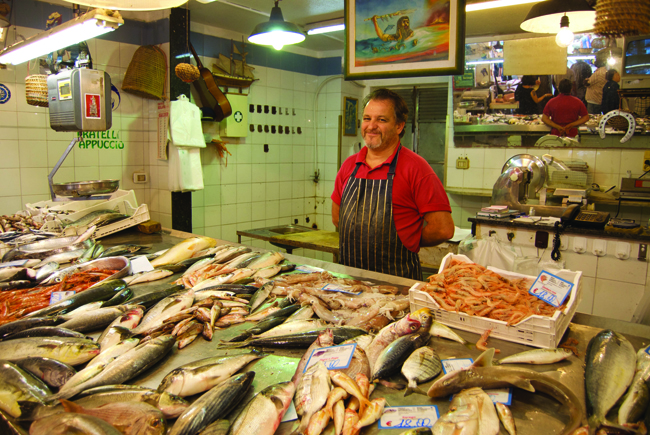
After a day of hitting Siracusa’s streets, we were ravenous. Ramona knew just the place, the Caseificio Borderi. Caseificios are traditionally a dairy or creamery, however the Famiglia Borderi have what can only be described as a delicatessen that is a treasure trove of local produce. We stood and chatted to one of the owners as he made a mountain of a panino for us to share, it was chock full of delicious local ingredients. Ramona was passionately discussing with him the characteristics of each ingredient and how they all fuel the body and soul in their own way. This was artisan gastronomy at its best! We sat and enjoyed the panino with a couple of glasses of local wine. Conversation was limited to mere sounds of appreciation whilst we savoured the feast.
I said my goodbyes to Ramona and we vowed to keep in contact, “You now have a friend in Ortigia!” she told me. And I was on my way to experience another one of Sicily’s charming towns, Taormina.
After an exhilarating evening drive I arrived at the San Domenico Palace hotel in Taormina. The illuminated entrance to the former monastery and now famously sumptuous hotel sets the scene perfectly for a stay in absolute luxury. I was shown to my suite that night and was quite simply blown away. The spacious suite was elegant, luxurious and looked resplendent, with classical artwork and furniture that had been impeccably chosen to match the grandeur of the room. I walked onto the balcony and could see fireworks igniting the coastline.
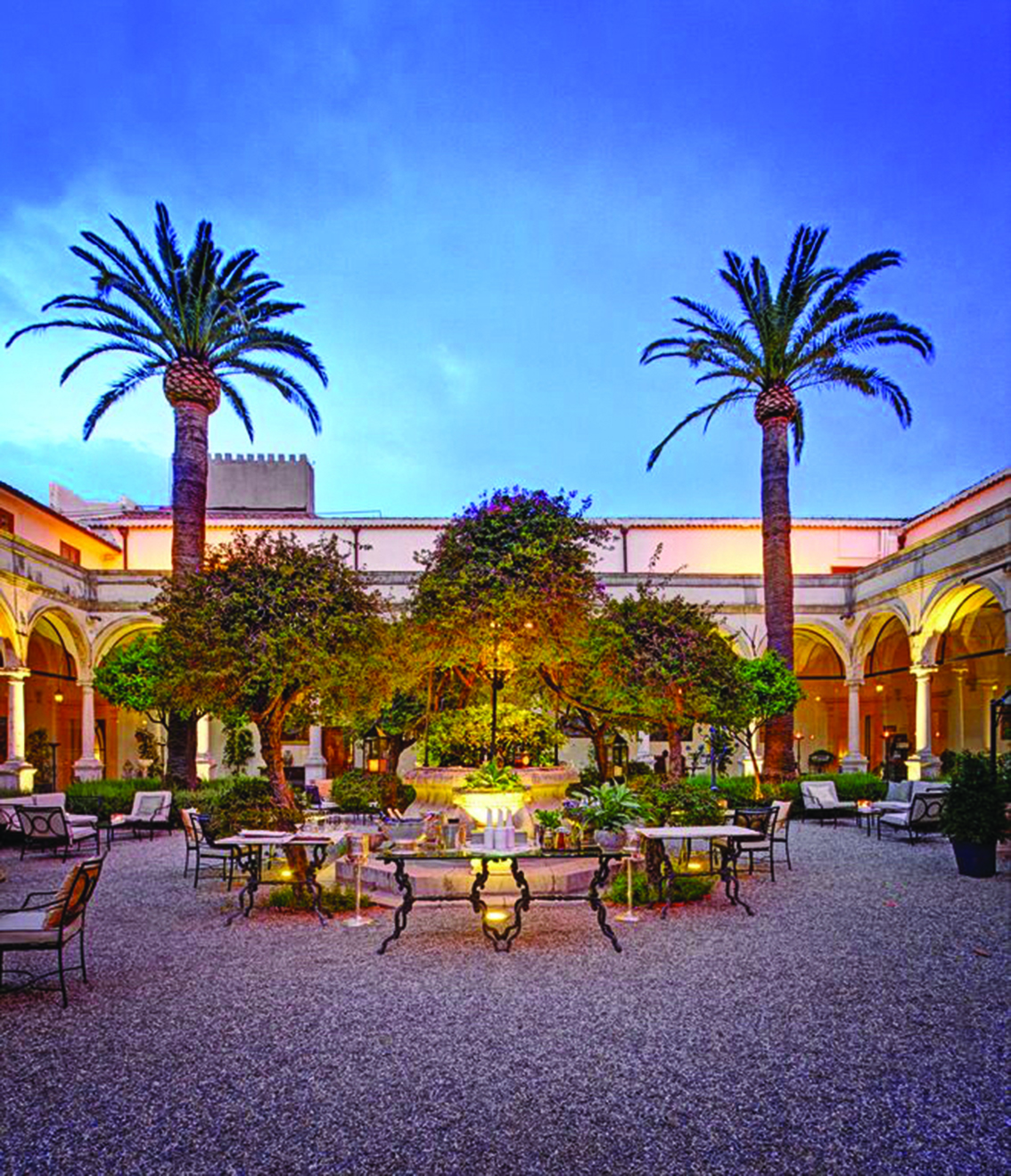
The San Domenico experience tends to make guests feel like they are occupying a scene in their own film. This was one of those moments. After enjoying a rested night in the decadence of my suite I enjoyed breakfast on the terrace whilst taking in views of the endless blue of the Ionian Sea. After breakfast I took a stroll around the hotel’s Italian garden – rare plants and explosions of colourful flowers, vistas out to Mount Etna and the sea. Reluctantly, I checked out of the San Domenico and decided to take in some of Taormina’s famous sights before heading back to Palermo.
Taormina is a hill top town known for its charming combination of ancient sites, natural beauty and classical glamour – so much so they stage the annual Taormina Film Festival here, where luminaries such as Brad Pitt and Angelina Jolie enjoy the string of beautiful piazzas that make up the main thoroughfare of the town’s centre. As I walked through the town centre, I could see why Taormina has a reputation of being something of a paradise – hanging baskets, beautiful balconies, quaint side streets with restaurants and bars. This was without doubt one of the most attractive towns I had visited in Italy.
Before leaving I visited the Greek Amphitheatre. The sense of drama this evoked was epic. The ancient seats offered views straight out to Mount Etna and the Sicilian coastline, a perfect location from which to accentuate the drama of the Greek tragedies of Antiquity played out here, and the bloodthirsty gladiatorial battles that took place under Roman rule.
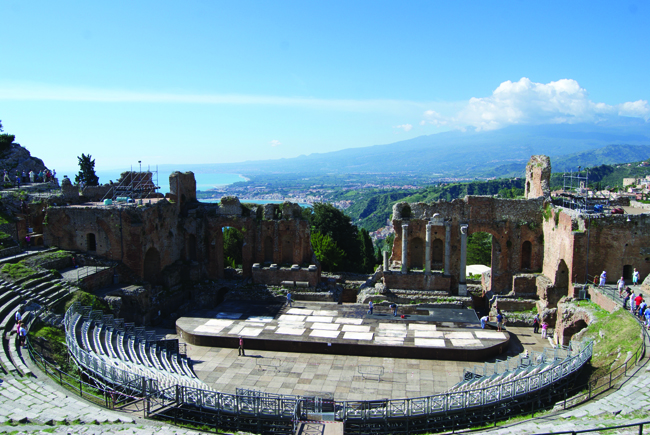
Readying myself for the journey home I contemplated my time in Taormina and Siracusa and remembered the man I had met in Siracusa and what he said Sicily offered him: time and space. I made a personal pledge to find the time and space in my life to return.
